Rear brake MITSUBISHI OUTLANDER 2018 Owner's Manual (in English)
[x] Cancel search | Manufacturer: MITSUBISHI, Model Year: 2018, Model line: OUTLANDER, Model: MITSUBISHI OUTLANDER 2018Pages: 441, PDF Size: 13.71 MB
Page 65 of 441
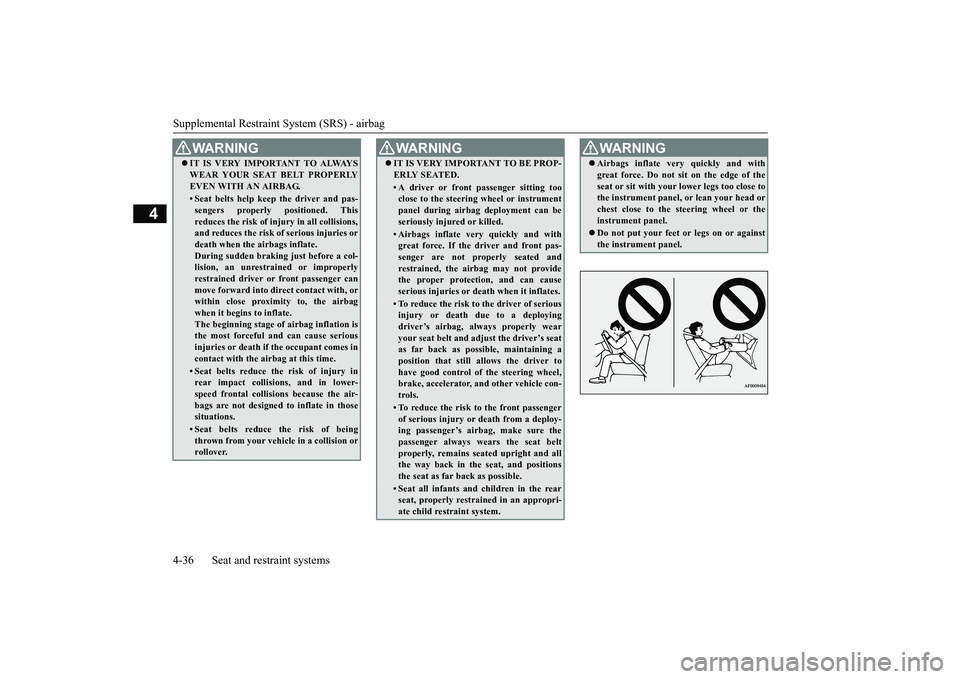
Supplemental Restraint System (SRS) - airbag4-36 Seat and restraint systems
4
WA R N I N GIT IS VERY IMPORTANT TO ALWAYSWEAR YOUR SEAT BELT PROPERLYEVEN WITH AN AIRBAG.• Seat belts help keep the driver and pas-sengers properly positioned. Thisreduces the risk of injury in all collisions,and reduces the risk of serious injuries ordeath when the airbags inflate.During sudden brakin
g just before a col-
lision, an unrestra
ined or improperly
restrained driver or front passenger canmove forward into di
rect contact with, or
within close proximity to, the airbagwhen it begins to inflate.The beginning stage of
airbag inflation is
the most forceful and can cause seriousinjuries or death if the occupant comes incontact with the ai
rbag at this time.
• Seat belts reduce the risk of injury inrear impact collisions, and in lower-speed frontal collisions because the air-bags are not designed
to inflate in those
situations.• Seat belts reduce the risk of beingthrown from your vehi
cle in a collision or
rollover.
WA R N I N GIT IS VERY IMPORTANT TO BE PROP-ERLY SEATED.• A driver or front passenger sitting tooclose to the steering wheel or instrumentpanel during airbag deployment can beseriously injure
d or killed.
• Airbags inflate ve
ry quickly and with
great force. If the driver and front pas-senger are not properly seated andrestrained, the airbag may not providethe proper protection, and can causeserious injuries or death when it inflates.• To reduce the risk to the driver of seriousinjury or death due to a deployingdriver’s airbag, al
ways properly wear
your seat belt and ad
just the driver’s seat
as far back as possible, maintaining aposition that still
allows the driver to
have good control of the steering wheel,brake, accelerator,
and other vehicle con-
trols.• To reduce the risk to the front passengerof serious injury or death from a deploy-ing passenger’s airbag, make sure thepassenger always we
ars the seat belt
properly, remains seat
ed upright and all
the way back in the seat, and positionsthe seat as far back as possible.• Seat all infants and children in the rearseat, properly restrain
ed in an appropri-
ate child restraint system.
WA R N I N GAirbags inflate very
quickly and with
great force. Do not sit on the edge of theseat or sit with your
lower legs too close to
the instrument panel,
or lean your head or
chest close to the steering wheel or theinstrument panel.Do not put your feet or
legs on or against
the instrument panel.
BK0249100US.book 36 ページ 2017年5月10日 水曜日 午前8時49分
Page 82 of 441
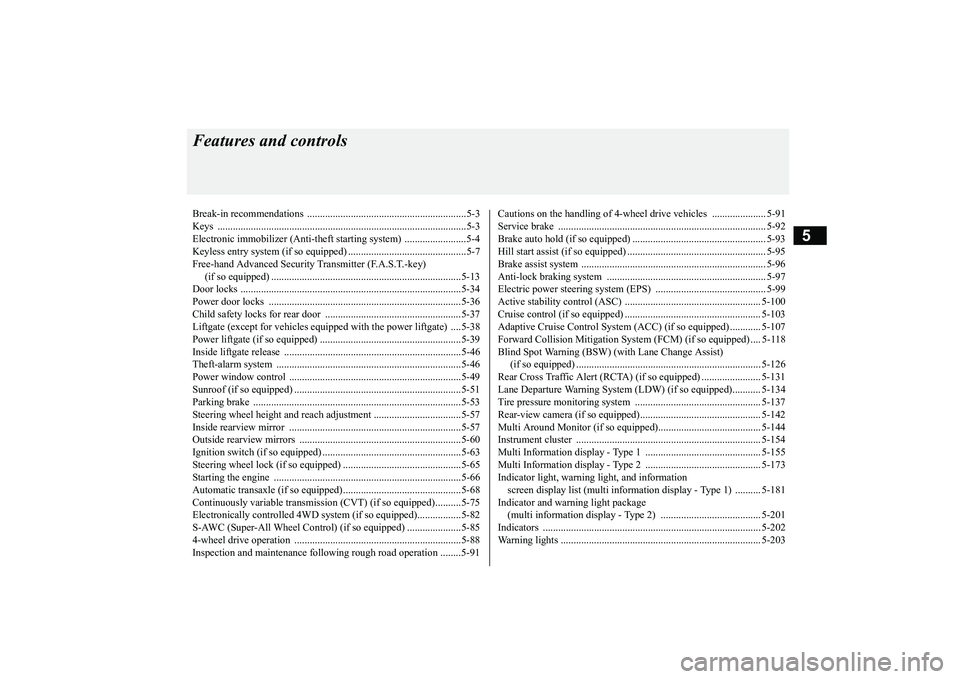
5
Features and controlsBreak-in recommendations ..............................................................5-3Keys .................................................................................................5-3Electronic immobilizer (Anti-theft starting system) ........................5-4Keyless entry system (if so equipped) ..............................................5-7Free-hand Advanced Security
Transmitter (F.A.S.T.-key)
(if so equipped) ..........................................................................5-13Door locks ......................................................................................5-34Power door locks ......
...........
...........
...........
...........
...........
.........
.....5-36
Child safety locks for rear door ..........
...........
.........
.........
.........
.....5-37
Liftgate (except for vehi
cles equipped with the
power liftgate) ....5-38
Power liftgate (if so equipped) .......................................................5-39Inside liftgate release .....................................................................5-46Theft-alarm system ........................................................................5-46Power window control ...................................................................5-49Sunroof (if so equipped) .................................................................5-51Parking brake .................................................................................5-53Steering wheel height and reach adjustment ..................................5-57Inside rearview mirror ...................................................................5-57Outside rearview mirrors ...............................................................5-60Ignition switch (if so equipped) ......................................................5-63Steering wheel lock (if so equipped) ..............................................5-65Starting the engine .........................................................................5-66Automatic transaxle (if so equipped)..............................................5-68Continuously variable transmission
(CVT) (if so equipped)..........5-75
Electronically controlled
4WD system (if so equipped).................5-82
S-AWC (Super-All Wheel Control) (if
so equipped) .....................5-85
4-wheel drive operation .................................................................5-88Inspection and maintenance followi
ng rough road operation ........5-91
Cautions on the handling of 4-wheel dr
ive vehicles ..................... 5-91
Service brake ................................................................................. 5-92Brake auto hold (if so equipped) .................................................... 5-93Hill start assist (if so equipped) ...................................................... 5-95Brake assist system ........................................................................ 5-96Anti-lock braking system .............................................................. 5-97Electric power steering system (EPS) ........................................... 5-99Active stability control (ASC) ..................................................... 5-100Cruise control (if so equipped) ..................................................... 5-103Adaptive Cruise Control System (ACC)
(if so equipped) ............ 5-107
Forward Collision Mitigation System
(FCM) (if so equipped) .... 5-118
Blind Spot Warning (BSW) (w
ith Lane Change Assist)
(if so equipped) ........................................................................ 5-126Rear Cross Traffic Alert (RCTA) (if so equipped) ....................... 5-131Lane Departure Warning System (LDW
) (if so equipped)........... 5-134
Tire pressure monitoring system ................................................. 5-137Rear-view camera (if so equipped)............................................... 5-142Multi Around Monitor (if so
equipped)..................
...........
........... 5-144
Instrument cluster ........................................................................ 5-154Multi Information display - Type 1 ............................................. 5-155Multi Information display - Type 2 ............................................. 5-173Indicator light, warning light, and information screen display list (multi informati
on display - Type 1) .......... 5-181
Indicator and warning light package (multi information display - Type 2) ....................................... 5-201Indicators ..................................................................................... 5-202Warning lights .............................................................................. 5-203
BK0249100US.book 1 ページ 2017年5月10日 水曜日 午前8時49分
Page 107 of 441

Free-hand Advanced
Security Transmitter (F.A.S
.T.-key) (if so equipped)
5
5. Press the engine switch.6. Confirm that all warning lights and warn-ing displays are functioning properly.
After several attempts
, you may experience
that the engine still does not start.1. Make sure that all electric devices, suchas lights, air conditi
oning blower and rear
window defogger, are turned off.2. While depressing the brake pedal, pressthe accelerator peda
l halfway and hold it
there, then crank th
e engine. Release the
accelerator pedal, immediately after theengine starts.
3. If the engine still wi
ll not start, the engine
could be flooded with too much gasoline.While depressing the brake pedal, pushthe accelerator pedal all the way downand hold it there, then press the engineswitch to crank the engine. If the enginedoes not start after 5 to 6 seconds, pushthe engine switch to stop cranking theengine, and release th
e accelerator pedal.
Put the operation mode in OFF. Wait afew seconds, and then press the engineswitch to crank the engine again whiledepressing the brake pedal, but do notpush the accelerator pedal. If the enginefails to start, repeat these procedures. Ifthe engine still will
not start, contact your
local Mitsubishi Motors dealer or a repairfacility of your choi
ce for assistance.
Startability of the en
gine with an ambient
temperature of -22 °F (-30 °C) or lowerWhen the ambient temperature is -22 °F (-30°C) or lower, it may not be possible to startfrom a standstill even wi
th the selector lever
in the
Page 138 of 441

Steering wheel height
and reach adjustment
Features and controls 5-57
5
Warning light (yellow)Warning displayIf there is a malfunction in the system, thewarning light will come on. In addition, thewarning display appears on the informationscreen in the multi information display.
Under normal conditions, the warning lightonly comes on when the operation mode isput in ON and goes off a few seconds later.
N00511501241
To adjust the steering wheel to the desiredposition, move the lever upward or down-ward while moving the steering wheel to thedesired position.
N00511601428
Adjust the inside rearview mirror only aftermaking any seat adjustme
nts so as to have a
clear view to the rear of the vehicle.
If you start driving wi
thout releasing the
Electric parking brake, the warning displaywill appear.If the driver’s foot contacts the acceleratorpedal in the condition th
at the Electric park-
ing brake can release by an automatic opera-tion, the Electric parking brake may bereleased automatically.
Wa r n i n g d is p la y
NOTE
CAUTIONWhen the Electric parking brake warninglight (yellow) does not
illuminate or remains
illuminated when the operation mode is putin ON, or comes on while driving, the Elec-tric parking brake may not be applied orreleased.Immediately contact the nearest authorizedMitsubishi Motors dealer
or a repair facility
of your choice. For detail
s, refer to “Electric
parking brake warni
ng light (yellow)” on
page 5-203.When parking your vehi
cle while the Elec-
tric parking brake warning light (yellow) isilluminated, park th
e vehicle on level and
stable ground, move the
selector lever to the
“P” (PARK) position and place chocks,blocks, or stones behind and in front of thetires to prevent the vehicle from moving.
Steering wheel height and reach adjustment
1- Wheel lock2- ReleaseWA R N I N GAfter adjusting, make sure the lock leveris secured in the locked (1) position.Do not attempt to adjust the steeringwheel while driving. This can be danger-ous.
Inside rearview mirror
12
BK0249100US.book 57 ページ 2017年5月17日 水曜日 午後2時31分
Page 148 of 441
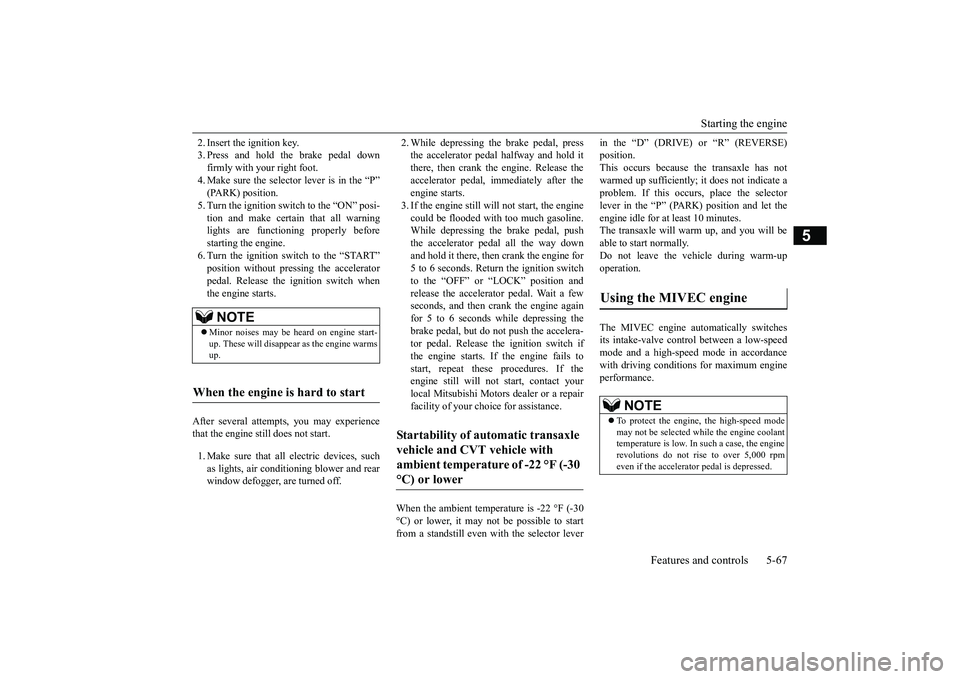
Starting the engine
Features and controls 5-67
5
2. Insert the ignition key.3. Press and hold the brake pedal downfirmly with your right foot.4. Make sure the selector
lever is in the “P”
5. Turn the ignition switch to the “ON” posi-tion and make certain that all warninglights are functioning properly beforestarting the engine.6. Turn the ignition switch to the “START”
ng the accelerator
pedal. Release the ignition switch whenthe engine starts.
After several attempts, you may experiencethat the engine still does not start.1. Make sure that all electric devices, suchas lights, air conditio
ning blower and rear
window defogger, are turned off.
2. While depressing the brake pedal, pressthe accelerator peda
l halfway and hold it
there, then crank th
e engine. Release the
accelerator pedal, immediately after theengine starts.3. If the engine still will not start, the enginecould be flooded with too much gasoline.While depressing the brake pedal, pushthe accelerator pedal all the way downand hold it there, then crank the engine for5 to 6 seconds. Retu
rn the ignition switch
to the “OFF” or “LOCK” position andrelease the accelerator pedal. Wait a fewseconds, and then crank the engine againfor 5 to 6 seconds while depressing thebrake pedal, but do no
t push the accelera-
tor pedal. Release the ignition switch ifthe engine starts. If the engine fails tostart, repeat these procedures. If theengine still will not
start, contact your
local Mitsubishi Motors dealer or a repairfacility of your choi
ce for assistance.
When the ambient temperature is -22 °F (-30°C) or lower, it may not be possible to startfrom a standstill even with the selector lever
in the
Page 164 of 441
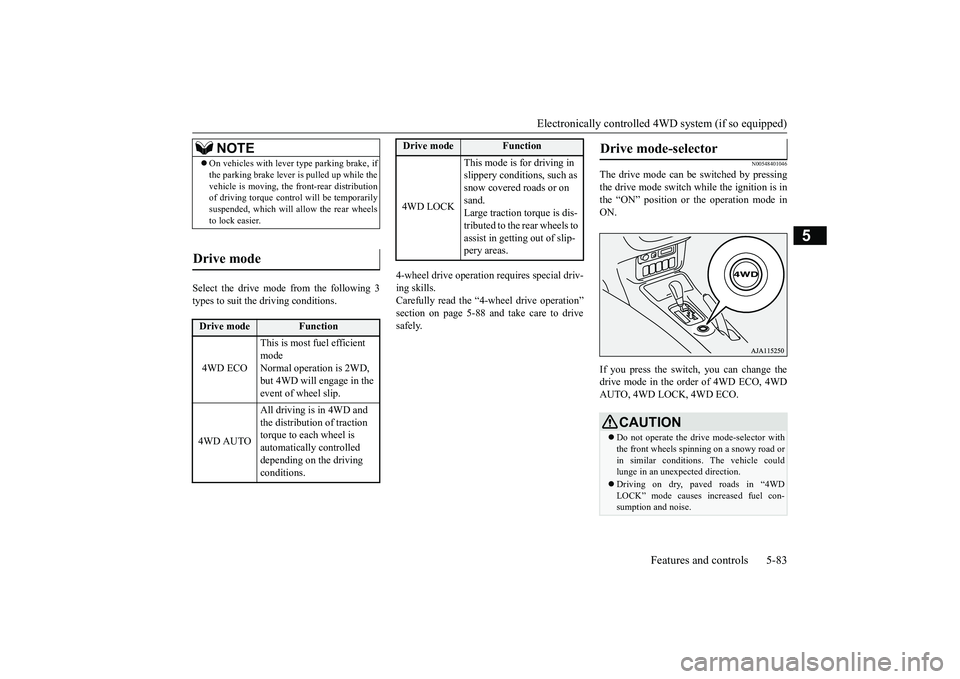
Electronically controlled 4WD system (if so equipped)
Features and controls 5-83
5
Select the drive mode from the following 3types to suit the driving conditions.
4-wheel drive operation requires special driv-ing skills.Carefully read the “4-wheel drive operation”section on page 5-88 and take care to drivesafely.
N00548401046
The drive mode can be switched by pressingthe drive mode switch while the ignition is inthe “ON” position or the operation mode inON.If you press the switch, you can change thedrive mode in the order of 4WD ECO, 4WDAUTO, 4WD LOCK, 4WD ECO.
NOTE
On vehicles with lever
type parking brake, if
the parking brake lever is pulled up while thevehicle is moving, the
front-rear distribution
of driving torque contro
l will be temporarily
suspended, which will allow the rear wheelsto lock easier.
Drive mode
Drive mode
Function
4WD ECO
This is most fuel efficient modeNormal operation is 2WD, but 4WD will engage in the event of wheel slip.
4WD AUTO
All driving is in 4WD and the distribution of traction torque to each wheel is automatically controlled depending on the driving conditions.
4WD LOCK
This mode is for driving in slippery conditions, such as snow covered roads or on sand.Large traction torque is dis-tributed to the rear wheels to assist in getting out of slip-pery areas.
Drive mode
Function
Drive mode-selector
CAUTIONDo not operate the drive mode-selector withthe front wheels spinning on a snowy road orin similar conditions
. The vehicle could
lunge in an unexpe
cted direction.
Driving on dry, paved roads in “4WDLOCK” mode causes increased fuel con-sumption and noise.
BK0249100US.book 83 ページ 2017年5月10日 水曜日 午前8時49分
Page 166 of 441
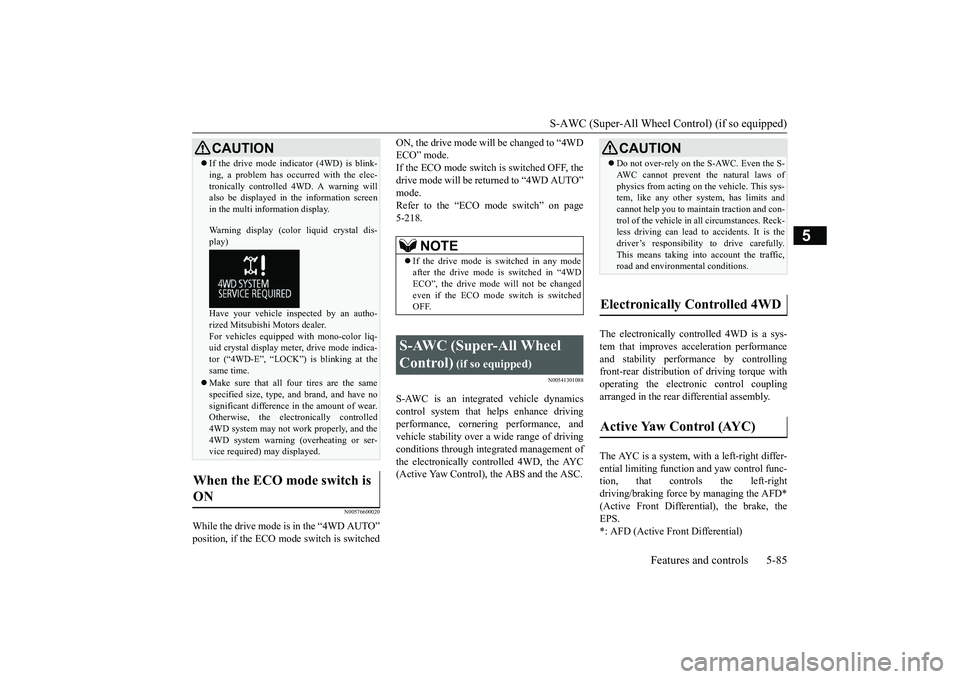
S-AWC (Super-All Wheel Co
ntrol) (if so equipped)
Features and controls 5-85
5
N00576600020
While the drive mode is in the “4WD AUTO”
ON, the drive mode will be changed to “4WDECO” mode.If the ECO mode switch is switched OFF, thedrive mode will be returned to “4WD AUTO”Refer to the “ECO mode switch” on page5-218.
N00541301088
S-AWC is an integr
ated vehicle dynamics
control system that helps enhance drivingperformance, cornering performance, andvehicle stability over a wide range of drivingconditions through integr
ated management of
the electronically cont
rolled 4WD, the AYC
(Active Yaw Control), the ABS and the ASC.
The electronically controlled 4WD is a sys-tem that improves acceleration performanceand stability performance by controllingfront-rear distribution of driving torque withoperating the electronic control couplingarranged in the rear differential assembly.The AYC is a system, with a left-right differ-ential limiting function
and yaw control func-
tion, that controls the left-rightdriving/braking force by managing the AFD*(Active Front Differential), the brake, theEPS.*: AFD (Active Front Differential)
If the drive mode indicator (4WD) is blink-ing, a problem has occurred with the elec-tronically controlled
4WD. A warning will
also be displayed in
the information screen
in the multi information display.Warning display (color
liquid crystal dis-
play)Have your vehicle in
spected by an autho-
rized Mitsubishi Motors dealer.For vehicles equipped with mono-color liq-uid crystal display mete
r, drive mode indica-
tor (“4WD-E”, “LOCK”)
is blinking at the
same time.Make sure that all four tires are the samespecified size, type, a
nd brand, and have no
significant difference
in the amount of wear.
Otherwise, the elec
tronically controlled
4WD system may not work properly, and the4WD system warning (overheating or ser-vice required) may displayed.
When the ECO mode switch is ON
CAUTION
NOTE
If the drive mode is switched in any modeafter the drive mode is switched in “4WDECO”, the drive mode
will not be changed
even if the ECO mode switch is switchedOFF.
S-AWC (Super-All Wheel Control)
(if so equipped)
Do not over-rely on the S-AWC. Even the S-AWC cannot prevent the natural laws ofphysics from acting on the vehicle. This sys-tem, like any other system, has limits andcannot help you to main
tain traction and con-
trol of the vehicle in
all circumstances. Reck-
less driving can lead to
accidents. It is the
driver’s responsibility to drive carefully.This means taking into account the traffic,road and environmental conditions.
Electronically Controlled 4WD
Active Yaw Control (AYC)
BK0249100US.book 85 ページ 2017年5月10日 水曜日 午前8時49分
Page 172 of 441
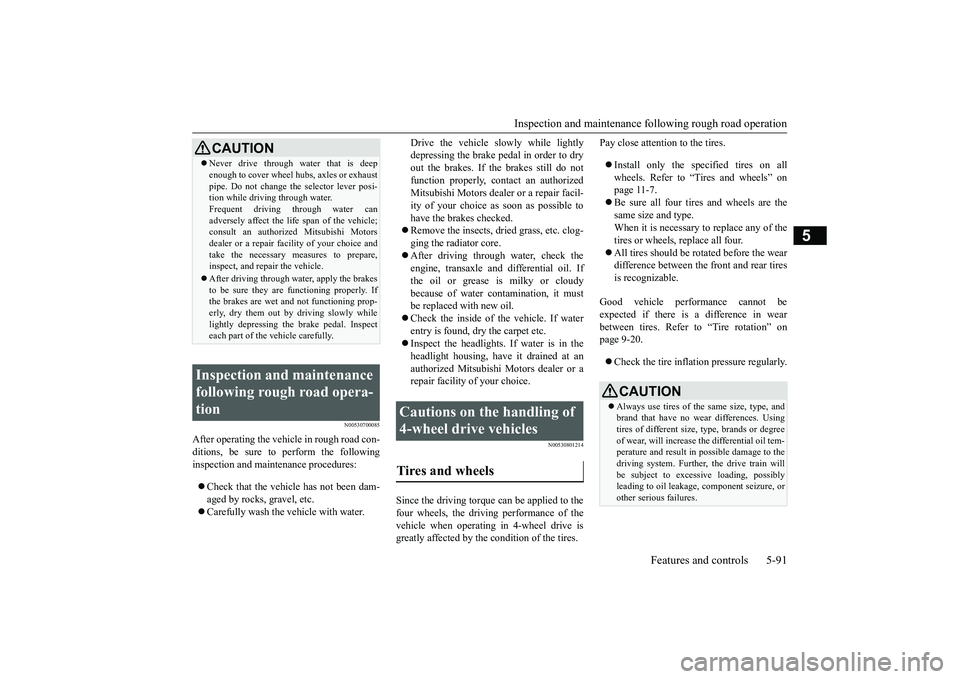
Inspection and maintenance following rough road operation
Features and controls 5-91
5
N00530700085
After operating the vehicle in rough road con-ditions, be sure to perform the followinginspection and maintenance procedures:Check that the vehicle has not been dam-aged by rocks, gravel, etc.Carefully wash the
vehicle with water.
Drive the vehicle slowly while lightlydepressing the brake pedal in order to dryout the brakes. If the brakes still do notfunction properly, contact an authorizedMitsubishi Motors dealer or a repair facil-ity of your choice as
soon as possible to
have the brakes checked.Remove the inse
cts, dried grass, etc. clog-
ging the radiator core.After driving through water, check theengine, transaxle and
differential oil. If
the oil or grease is milky or cloudybecause of water c
ontamination, it must
be replaced with new oil.Check the inside of the vehicle. If waterentry is found, dry the carpet etc.Inspect the headlights. If water is in theheadlight housing, have
it drained at an
authorized Mitsubishi
Motors dealer or a
repair facility of your choice.
N00530801214
Since the driving torque can be applied to thefour wheels, the driving performance of thevehicle when operating in 4-wheel drive isgreatly affected by the condition of the tires.
Pay close attention to the tires.Install only the specified tires on allwheels. Refer to “Tires and wheels” onpage 11-7.Be sure all four tire
s and wheels are the
same size
and type.
When it is necessary to replace any of thetires or wheels, replace all four.All tires should be rotated before the weardifference between the
front and rear tires
is recognizable.
Good vehicle performance cannot beexpected if there is a difference in wearbetween tires. Refer to “Tire rotation” onpage 9-20.Check the tire inflati
on pressure regularly.
CAUTIONNever drive through water that is deepenough to cover wheel hubs, axles or exhaustpipe. Do not change th
e selector lever posi-
tion while driving through water.Frequent driving through water canadversely affect the life
span of the vehicle;
consult an authorized Mitsubishi Motorsdealer or a repair faci
lity of your choice and
take the necessary measures to prepare,inspect, and repair the vehicle.After driving through wa
ter, apply the brakes
to be sure they are functioning properly. Ifthe brakes are wet and not functioning prop-erly, dry them out by
driving slowly while
lightly depressing the
brake pedal. Inspect
each part of the vehicle carefully.
Inspection and maintenance following rough road opera-tion
Cautions on the handling of 4-wheel drive vehicles Tires and wheels
CAUTIONAlways use tires of th
e same size, type, and
brand that have no wear differences. Usingtires of different size,
type, brands or degree
of wear, will increase the differential oil tem-perature and result in
possible damage to the
driving system. Further, the drive train willbe subject to excessi
ve loading, possibly
leading to oil leakage, component seizure, orother serious failures.
BK0249100US.book 91 ページ 2017年5月10日 水曜日 午前8時49分
Page 173 of 441

Service brake5-92 Features and controls
5
N00517500275
Overuse of the brake can cause weakening,resulting in poor brake response and prema-ture wear of the brake pads.When driving down a long or steep hill, useengine braking
by downshifting.
N00517600364
Your vehicle is equipped with power brakesfor more braking force with less brake pedaleffort.Your brakes are designed to operate at fullcapacity, even if the power assist is not beingused.If the power assist is not being used, the effortneeded to press the brake pedal is greater.If you should lose the power assist for somereason, the brakes will still work.If the power brake unit or either of the twobrake hydraulic systems stops working prop-erly, the rest of the brake system will stillwork, but the vehicle will not slow down asquickly.You will know this has happened if you findyou need to press the brake down farther, orharder when slowing down or stopping, or ifthe brake warning light and the warning dis-play in the multi-information display comeon.
To w i n g
CAUTIONDo not tow 4-wheel drive vehicles with thefront or rear wheels on the ground (Type Aor Type B) as illustrate
d. This could result in
damage to the drivetrain, or unstable towing.If you tow 4-wheel drive vehicles, use TypeC or Type D equipment.Even in “4WD ECO” (Electronically con-trolled 4WD) or “AWC ECO” (S-AWC)drive mode, the vehicle cannot be towedwith the front or the rear wheels on theground.
Jacking up a 4-wheel drive vehicle
WA R N I N GDo not crank the engine while jacking upthe vehicle.The tire on the ground may turn and thevehicle may roll off the jack.
Service brake Brake pedal
WA R N I N GDo not leave any objects near the brakepedal or let a floor mat slide under it;doing so could prevent the full pedalstroke that would be necessary in anemergency. Make sure that the pedal canbe operated freely at all times. Make surethe floor mat is securely held in place.
CAUTIONIt is important not to drive the vehicle withyour foot resting on the brake pedal whenbraking is not required.
This practice can
result in very high brake temperatures, pre-mature lining wear, a
nd possible damage to
the brakes.
Power brakes
BK0249100US.book 92 ページ 2017年5月10日 水曜日 午前8時49分
Page 180 of 441
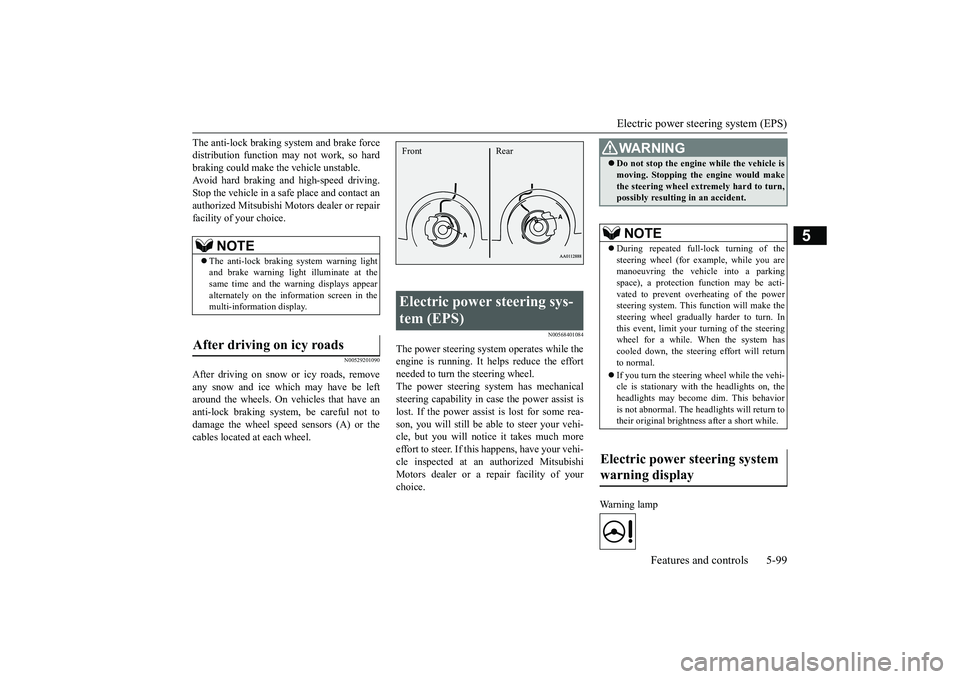
Electric power steering system (EPS)
Features and controls 5-99
5
The anti-lock braking system and brake forcedistribution function ma
y not work, so hard
braking could make the vehicle unstable.Avoid hard braking and high-speed driving.Stop the vehicle in a safe place and contact anauthorized Mitsubishi Mo
tors dealer or repair
facility of your choice.
N00529201090
After driving on snow or icy roads, removeany snow and ice which may have be leftaround the wheels. On vehicles that have ananti-lock braking syst
em, be careful not to
damage the wheel spee
d sensors (A) or the
cables located at each wheel.
N00568401084
The power steering system operates while theengine is running. It helps reduce the effortneeded to turn the steering wheel.The power steering sy
stem has mechanical
steering capability in case the power assist islost. If the power assist is lost for some rea-son, you will still be able to steer your vehi-cle, but you will notice it takes much moreeffort to steer. If this happens, have your vehi-cle inspected at an authorized MitsubishiMotors dealer or a repair facility of yourchoice.
Warning lamp
NOTE
The anti-lock braking
system warning light
and brake warning light illuminate at thesame time and the wa
rning displays appear
alternately on the information screen in themulti-information display.
After driving on icy roads
Electric power steering sys-tem (EPS) Front Rear
WA R N I N GDo not stop the engine while the vehicle ismoving. Stopping the engine would makethe steering wheel extremely hard to turn,possibly resulting
in an accident.
NOTE
During repeated full-lock turning of thesteering wheel (for example, while you aremanoeuvring the vehicle into a parkingspace), a protection f
unction may be acti-
vated to prevent overheating of the powersteering system. This f
unction will make the
steering wheel graduall
y harder to turn. In
this event, limit your turning of the steeringwheel for a while. When the system hascooled down, the steering effort will returnto normal.If you turn the steering wheel while the vehi-cle is stationary with the headlights on, theheadlights may become
dim. This behavior
is not abnormal. The he
adlights will return to
their original brightness after a short while.
Electric power steering system warning display
BK0249100US.book 99 ページ 2017年5月10日 水曜日 午前8時49分